26 October 2011
Strained Timiskaming-type metaconglomerates from Ontario
Posted by Callan Bentley
Why are these geologists all over these rocks?

Because, gentle readers, these are some seriously cool rocks.
The geologists are all participants on a pre-GSA-annual-meeting field trip to the Superior Craton, a chunk of ancient crust at the “nucleus” of the North American continent.
The rocks are syn-tectonic volcaniclastic conglomerates of the Seine Group. They are Archean sediments very similar to modern day conglomerates – full of cobbles and pebbles and sand, that were deposited in modest wrench basins formed in releasing bends along the edges of transpressional embryonic orogens. Way back when, small proto-continental masses were colliding with one another along what we today call greenstone belts, and as they mishmashed into place, dilational basins opened up, ready to receive the sloughed-off clastic detritus of the primordial mountains. Collectively, this style of tectonically-induced deposition in Archean greenstone belts is called “Timiskaming,” for a place elsewhere in Ontario on the Superior Craton, where rocks of this type were first described. These are about 2.7 billion years old, and formed in the boundary zone between the Quetico and Wabigoon sub-provinces of the Superior Craton.
Here, on the structural geology field trip to examine the sub-province boundaries within the Superior Craton, our field trip leader Dyanna Czeck brought us to these rocks because (a) they are the most photogenic rocks in the world, and (b) they are an excellent place to study strain in a polymictic (lots of different clast compositions) conglomerate.
Here are three horizontal outcrops to give you a sense of why we were there:
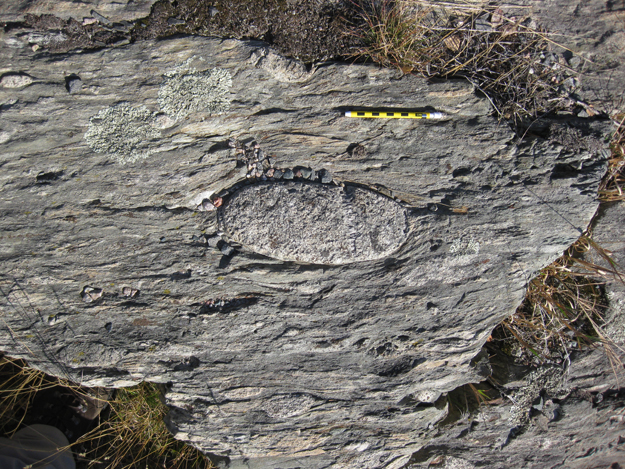
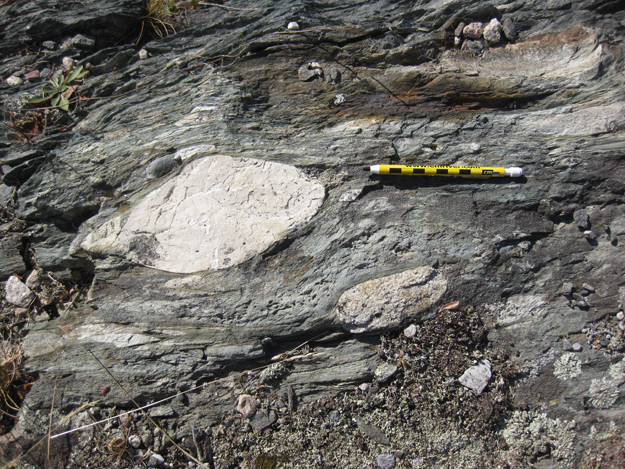
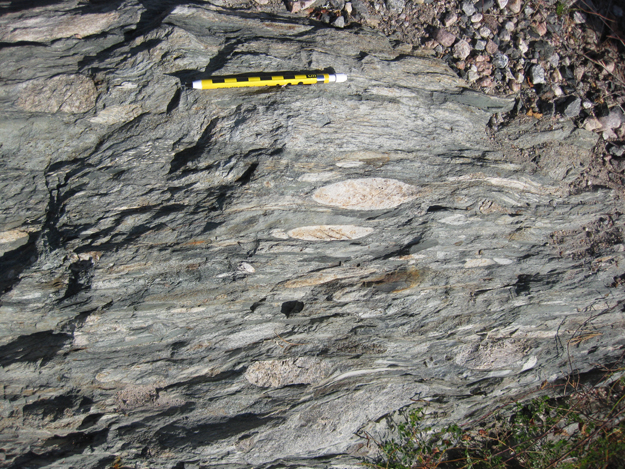
A short vertical outcrop:
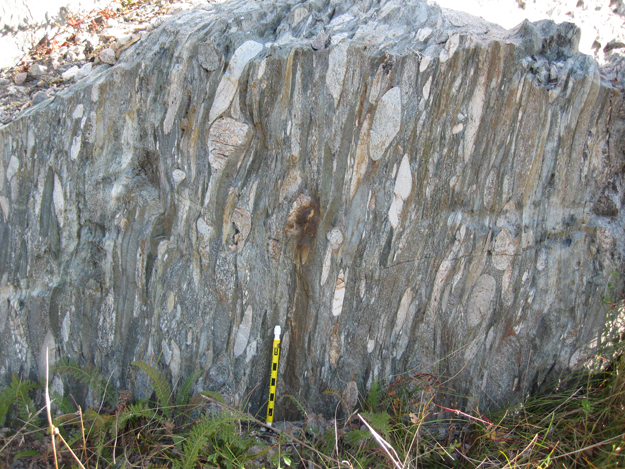
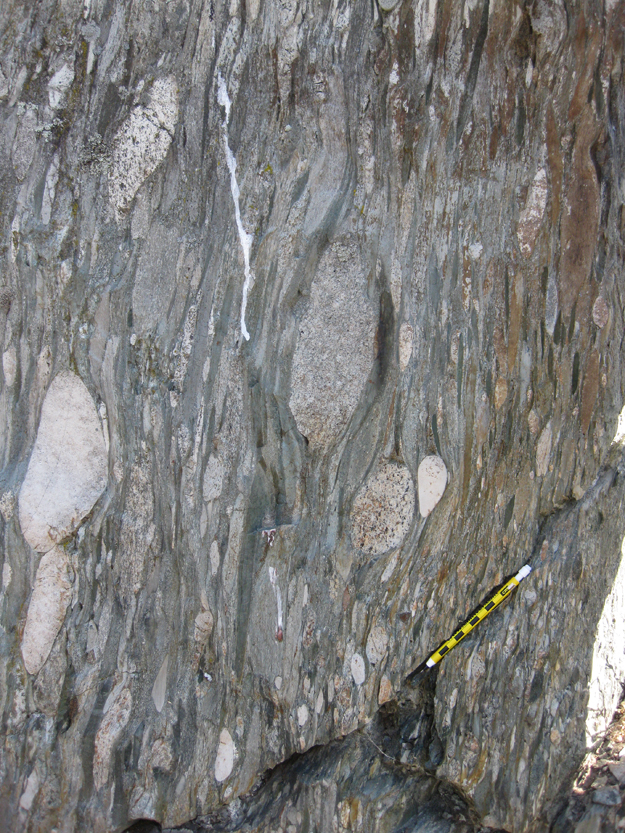
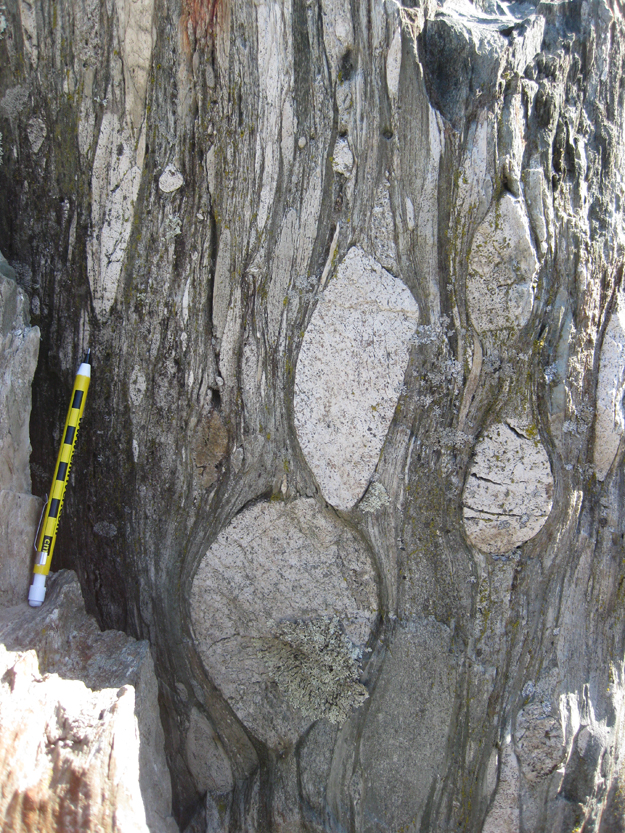
This next shot shows well how differently the different clasts responded to the stresses of Archean transpression. Some shmooed out. Others held up strong as rigid resistant chunks:
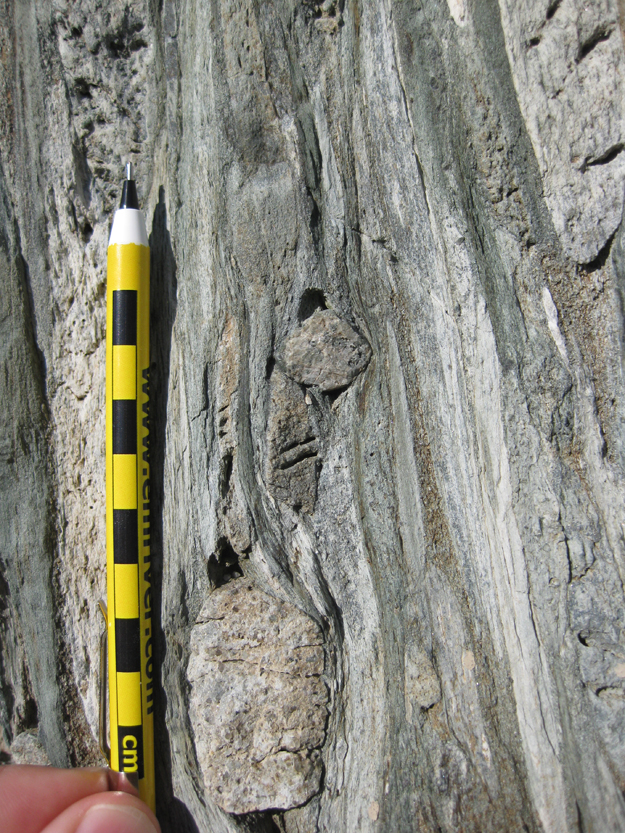
The less competent clasts wrap around the more competent clasts:
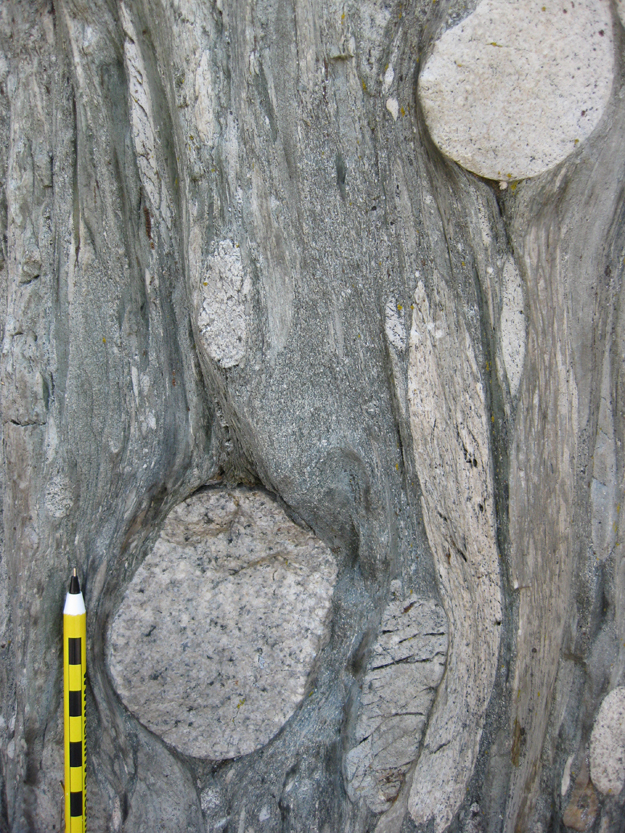
What at first might appear to be matrix, in fact turns out to be a zone of gazillions of smeared-out clasts:

Smeared out clasts galore become undiscernible as individual units, and instead what we see is a pronounced “transposition foliation”:
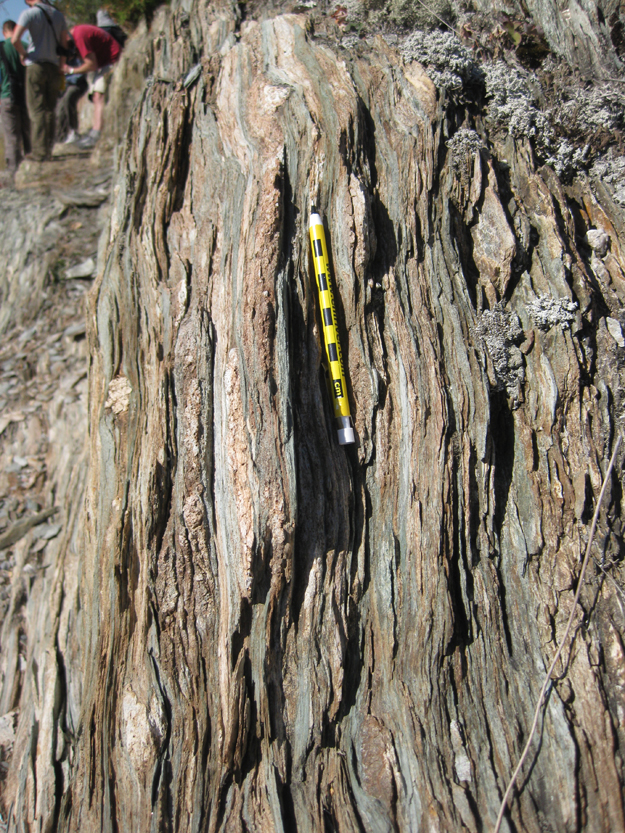
Looking at that last one, it’s kind of hard to imagine it was once a robust knobbly conglomerate, eh? Such, such are the joys of transpressional flattening strains. My favorite parts of these outcrops were the ones that showed a variety of rheological responses to stress: Some cobbles highly strained, others not so much:
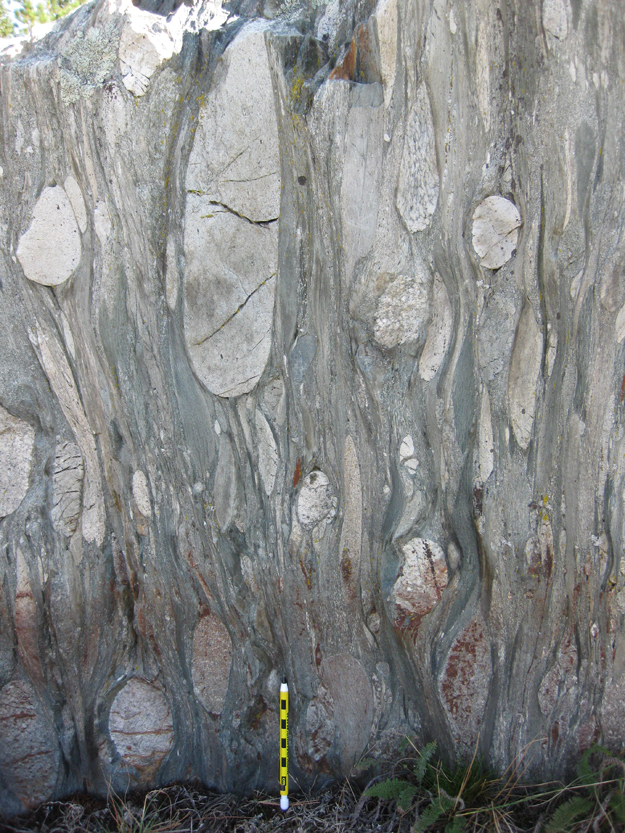
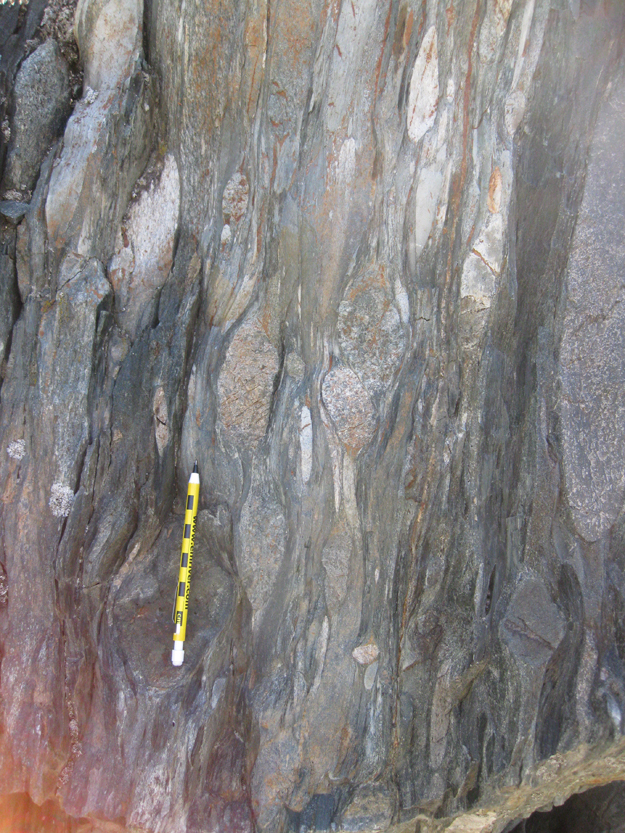
Wow. Seriously photogenic rocks.
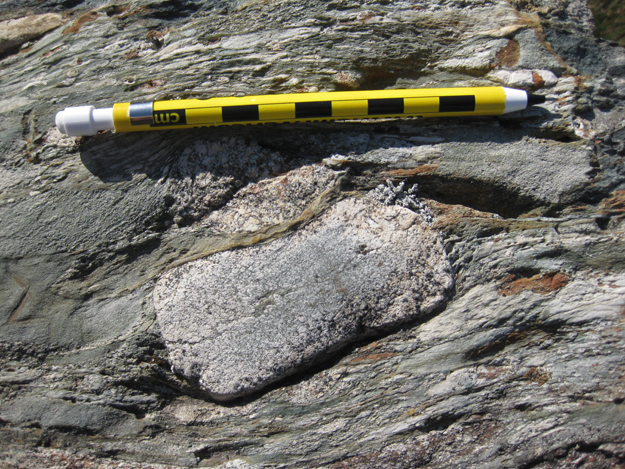

Note the glacial striations decorating the outcrop surface in the next two shots. These come from the Pleistocene-aged contintental glaciation of the central North American continent – the “Laurentide ice sheet”:
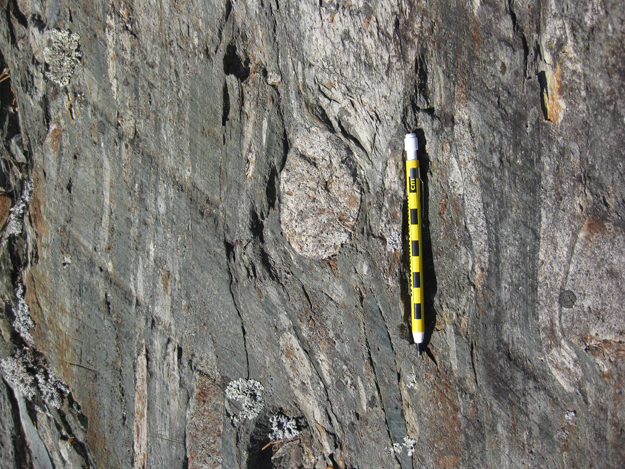

In some places you can still see sedimentary structures, like the bedding that is parallel to foliation in this picture (sandy above, gravelly below):

Another vertical cross-sectional view, where the outcrop is perpendicular to foliation:
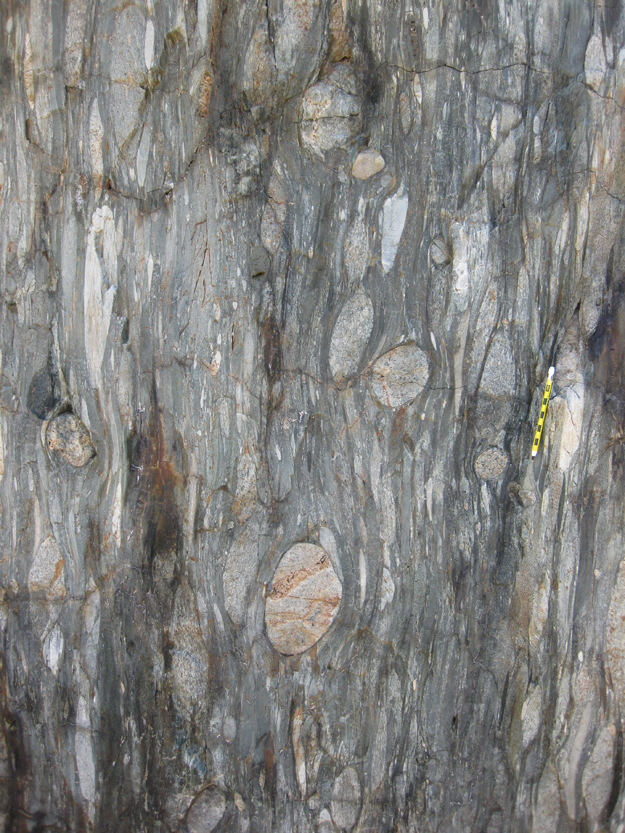
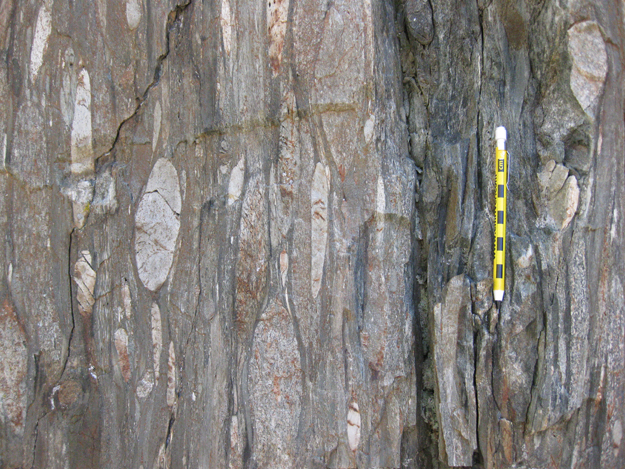
I like how this clast has a long axis that is perpendicular to foliation. It’s like a toothpick in a club sandwich:
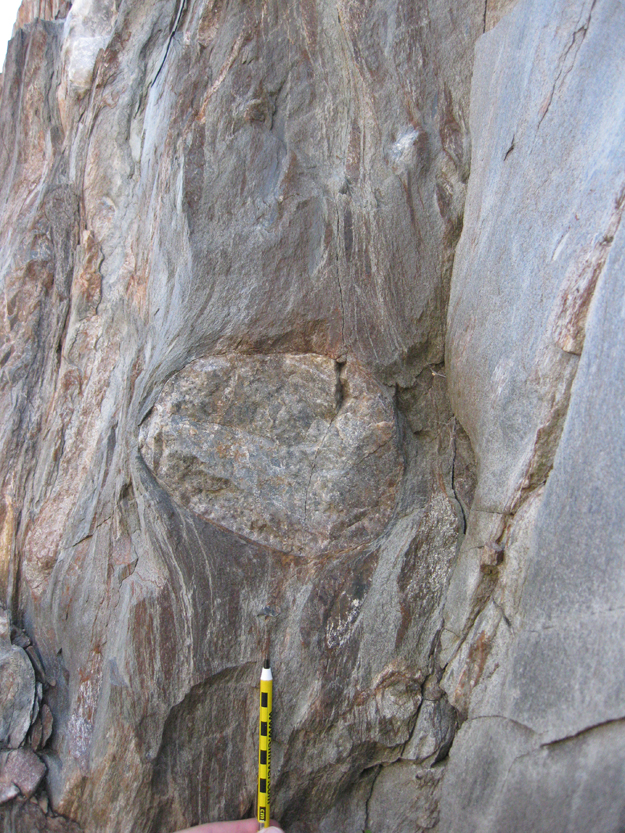
Nice top-to-the-right (“dextral”) kinematics on the next five:
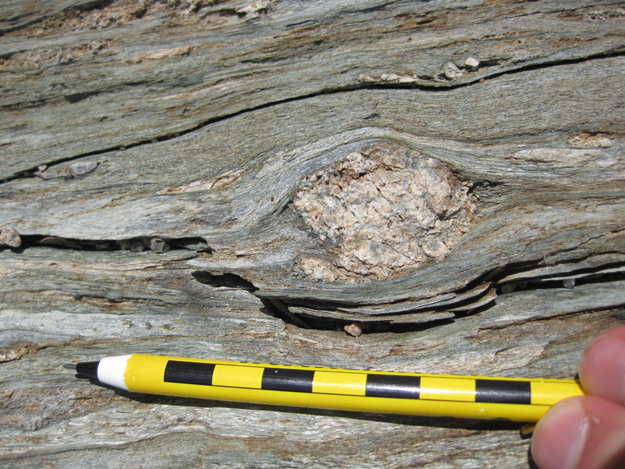
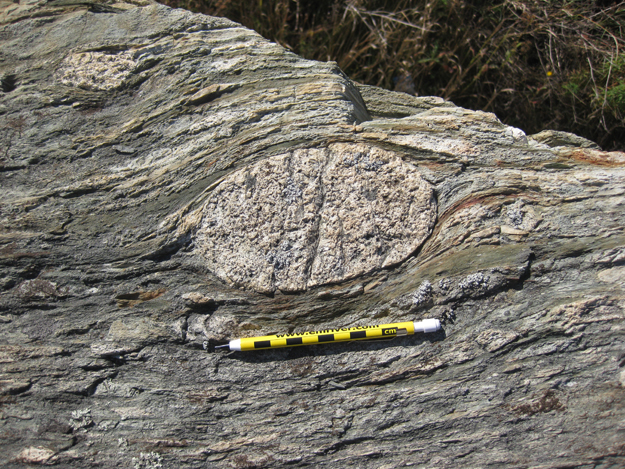

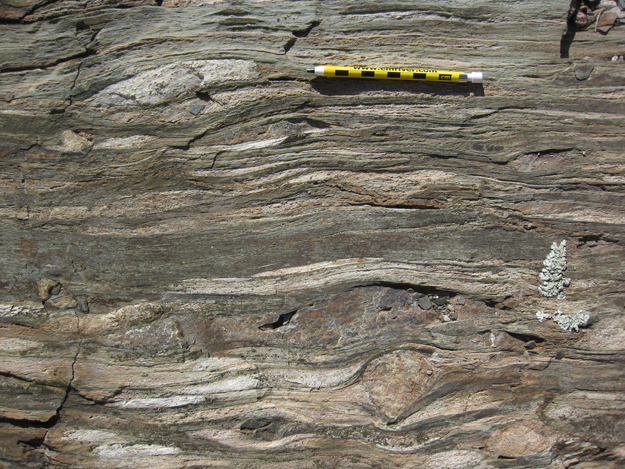
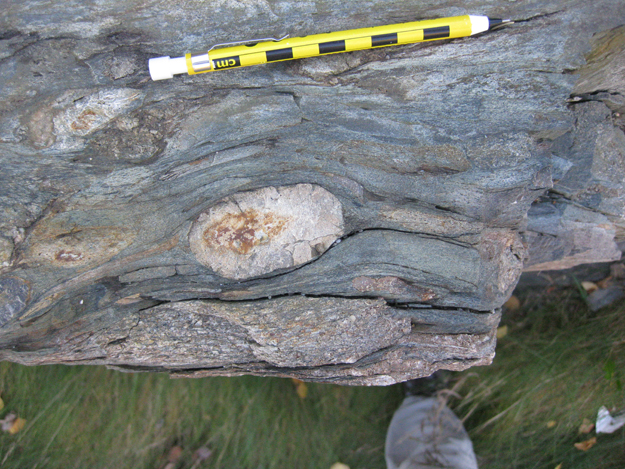
I like how these two clasts have become imbricated through deformation – strangers from different backgrounds, one strong; one weak. They are thrust together by extraordinary circumstances:
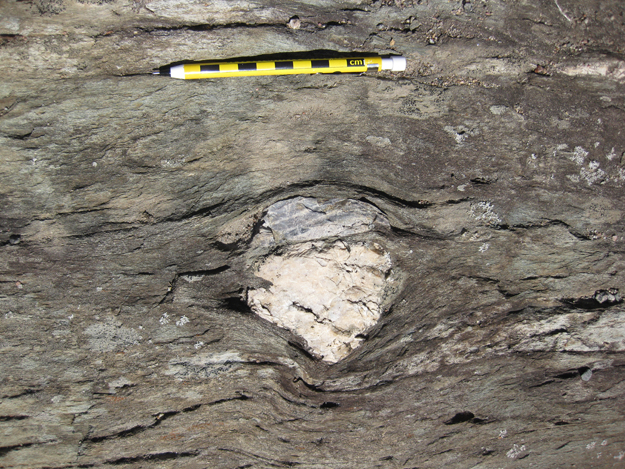
…sounds like a plot for a romantic drama… one embraces the other.
Now check this out – it’s the opposite sort of situation, where a single clast gets broken in two, and they move off in opposite directions:

That one’s worth zooming in on, I think:
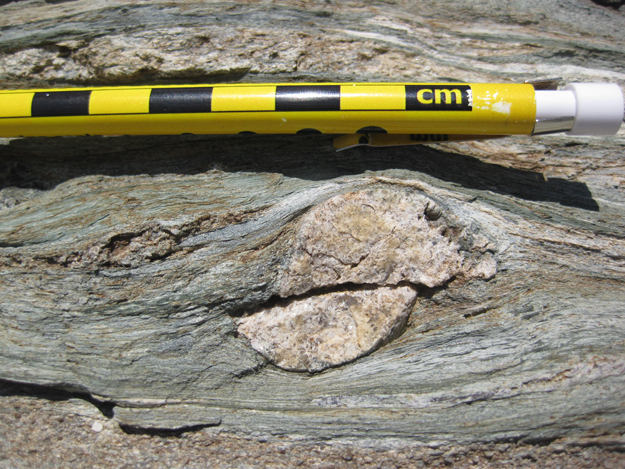
This is a kind of bookshelfing (but with only two “books”). If they separate enough from one another, strung out along the plane of foliation, we might say they were boudinaged.
What profoundly cool rocks. I know I’ve likely overwhelmed you (or your dial-up modem) with all these photos, but I can’t resist sharing them.
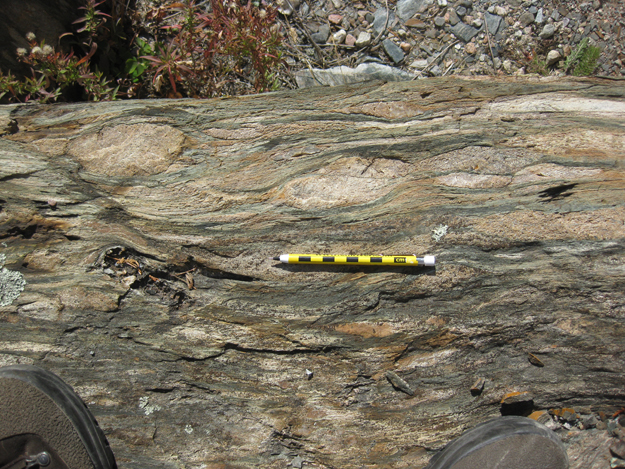
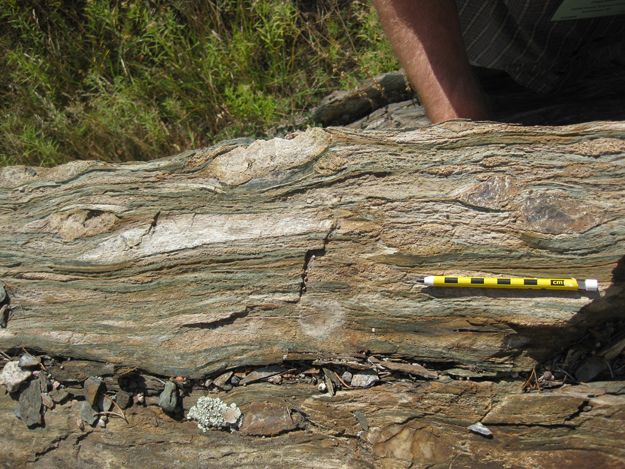
Okay; let’s mix things up now, and take a look at the plane of foliation. Everything I’ve showed you so far has been either horizontal outcrop surfaces (perpendicular to foliation) or vertical outcrop surfaces (perpendicular to foliation). Now let’s rotate 90°, and check out a vertical outcrop surface that is parallel to foliation:
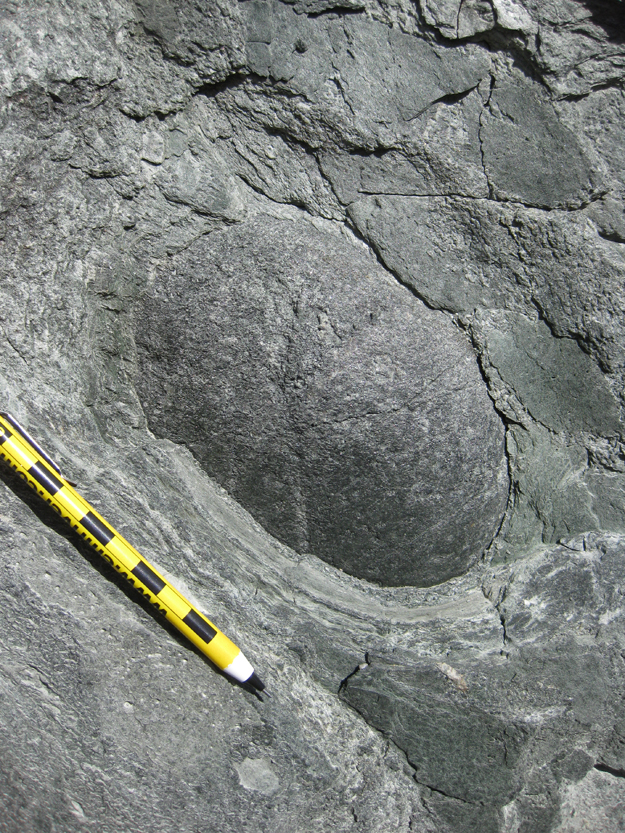
Nice. This is the “XY” plane of the strain ellipsoid, with the long axis of the clast (upper left to lower right) presumably parallel to the long axis of the strain ellipsoid (“X” axis). This is sometimes called a stretching lineation. The lineation in the previous photo plunges to the right side of the photo.
Another look, elsewhere on this same plane:
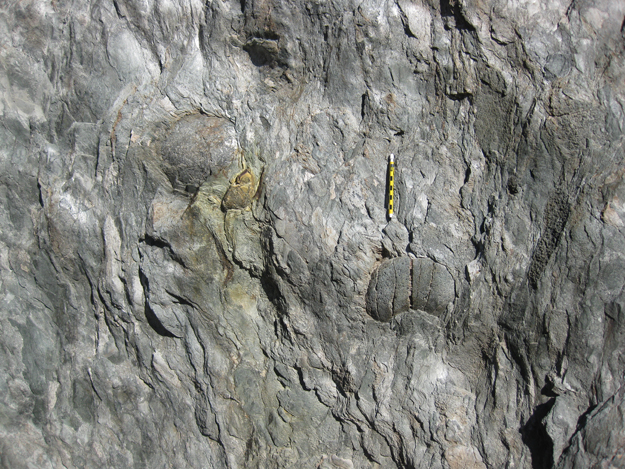
Zooming in on that dark green clast in the middle, we see extensional veins that interrupt its continuity:

This is awesome. While neighboring clasts are smearing out into unrecognizable wisps, this solid chunky fellow is deforming in a very different fashion – failing brittlely, with fibrous vein quartz filling the gaps between the fragments.
Another outcrop, also showing lineations on the plane of foliation, plunging to the right.
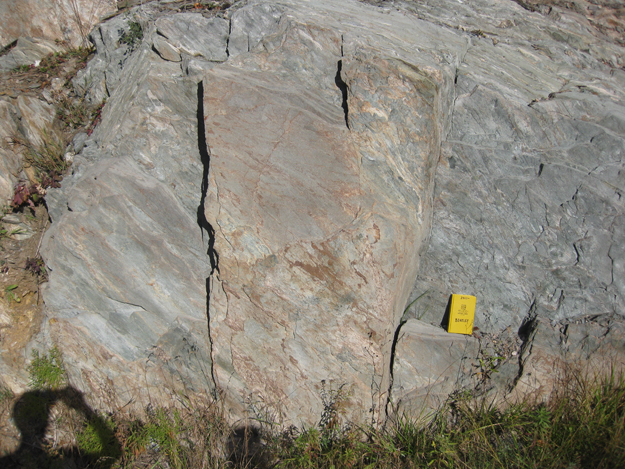
A different outcrop, showing lineation plunging to the left:
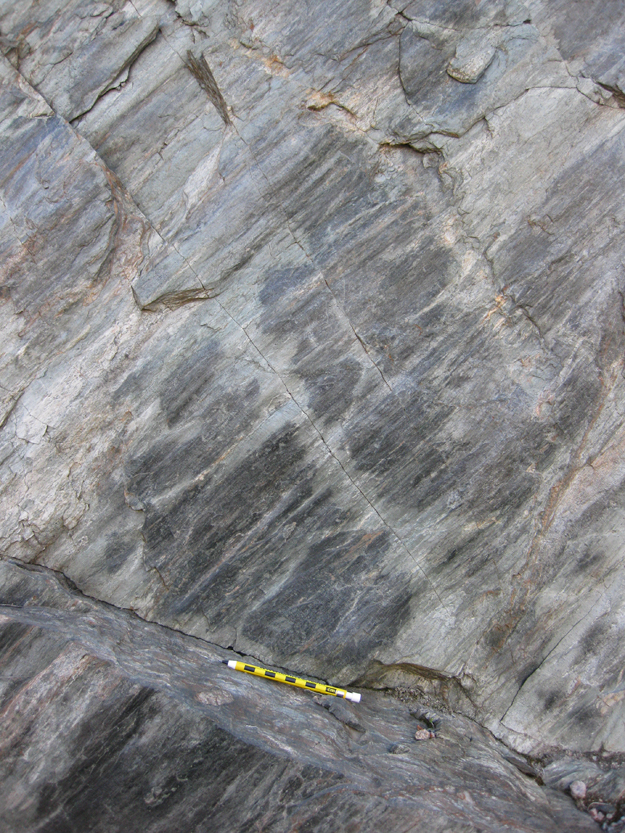
How lineation develops in high-strain zones was the subject of my geology master’s thesis, and in that work, I had cited a study by Dyanna and her advisor Peter Hudleston (also a field trip leader on this trip) looking at these very same rocks as a field example. It was cool for me, seven years later, to get to see them in person!
We also saw some examples of folding which disturbed the foliation of pancake-shaped clasts:
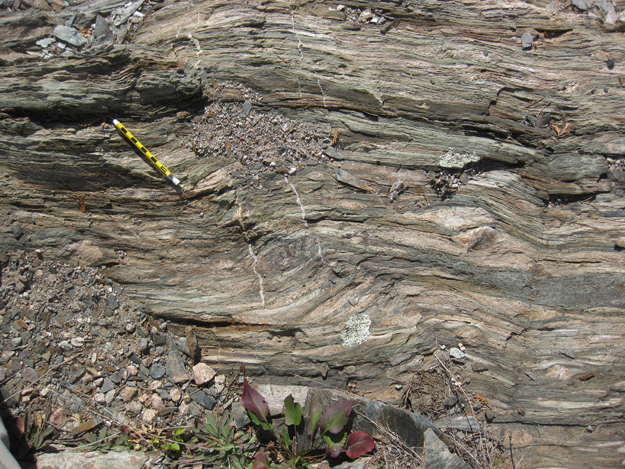

…And that’s why those geologists are clustered all over these rocks!



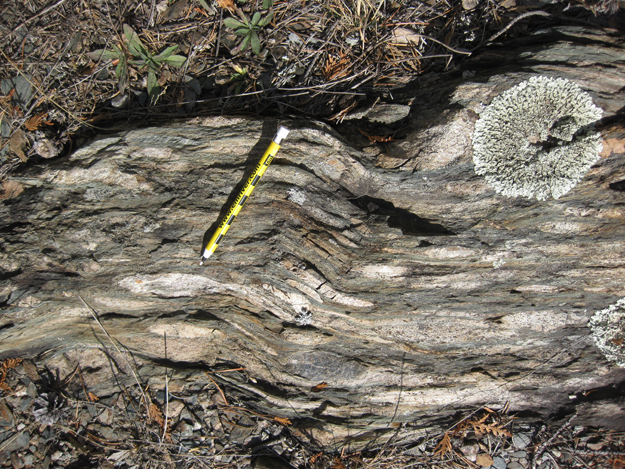
 Callan Bentley is Associate Professor of Geology at Piedmont Virginia Community College in Charlottesville, Virginia. He is a Fellow of the Geological Society of America. For his work on this blog, the National Association of Geoscience Teachers recognized him with the James Shea Award. He has also won the Outstanding Faculty Award from the State Council on Higher Education in Virginia, and the Biggs Award for Excellence in Geoscience Teaching from the Geoscience Education Division of the Geological Society of America. In previous years, Callan served as a contributing editor at EARTH magazine, President of the Geological Society of Washington and President the Geo2YC division of NAGT.
Callan Bentley is Associate Professor of Geology at Piedmont Virginia Community College in Charlottesville, Virginia. He is a Fellow of the Geological Society of America. For his work on this blog, the National Association of Geoscience Teachers recognized him with the James Shea Award. He has also won the Outstanding Faculty Award from the State Council on Higher Education in Virginia, and the Biggs Award for Excellence in Geoscience Teaching from the Geoscience Education Division of the Geological Society of America. In previous years, Callan served as a contributing editor at EARTH magazine, President of the Geological Society of Washington and President the Geo2YC division of NAGT.
Amazing photos. Thanks for sharing!
Two of my senior thesis students are working on a strained conglomerate in the mountains near here, using Dyanna’s (and Adolph Yonkee’s) techniques. Strained conglomerates are definitely awesome rocks.
Gorgeous! Let’s hope and pray that the Ontario Ministry of Highways never has it in their budget to “remediate” this roadcut.
Dang. Thanks for your lavish use of photos from this awesome site.
Is “shmooed” a technical term? 😉 I think it’s my favorite geology word so far! Lots of delicious images and words in this. Those rocks have obviously seen a lot of exciting events in the course of over two billion years. I love the fact that geologists like you can translate their stories!
[…] up from the astonishing first couple of outcrops we saw of strained Seine Group metaconglomerate from the boundary between the Wabigoon and Quetico sub-provinces of the Superior Craton, our group […]
[…] Strained metaconglomerate photos by Callan Bentley a fabulous example of how rocks flow like putty when deep/hot enough. https://blogs.agu.org/mountainbeltway/2011/10/26/strained-timiskaming/ […]
[…] the awesome outcrops and pavements of strained metaconglomerates from the Quetico / Wabigoon subprovince boundaries of […]
[…] geology.about.com, and together we checked out a poster on strained metaconglomerates (of apparent Timiskaming type). Then I had to scoot – I had an appointment in another part of town – but as I left I […]